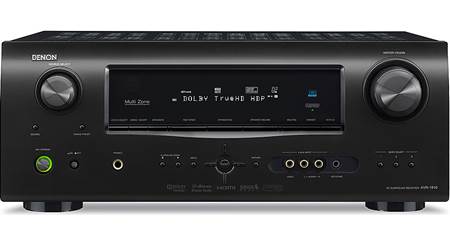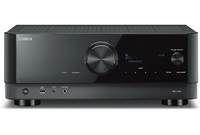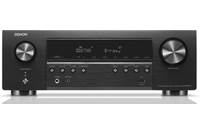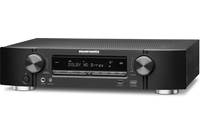About the Denon AVR-1911

Denon's AVR-1911 is arguably a bit of an overachiever. It provides gripping, engaging surround sound with all your movies and video games; boasts high-quality connections for high-def video; and offers lots of options for music lovers. But it doesn't stop there. Unlike other receivers, it can pass high-definition 3D video signals from a 3D Blu-ray player to your 3D TV — no mean feat, since that's nearly twice the bandwidth of a 1080p HD signal. It's a smart choice for anyone interested in 3D at home, whether you're planning to put together a 3D TV system now, or a few years down the road.
Plug your iPod® straight into the front panel — your favorite tunes will sound clearer
Quite a few receivers have a USB input, but the AVR-1911's front-panel USB is special. It has dedicated iPod support — you simply connect your iPod or iPhone using its supplied USB cable, and press Play on the receiver's remote. More goodness: Instead of the sound quality being limited by the iPod's made-for-earbuds audio circuitry, digital signals are sent straight to the Denon's high-quality DACs, so all your favorite tunes will sound better. Or plug in a USB flash memory drive, or hard disk drive loaded with your music. Switch on Denon's Compressed Audio Restorer mode to flesh out the sound of your MP3 collection. Adding an optional Denon iPod dock lets you enjoy photos and videos too.
Super sharp video and a cleaner setup
The '1911 can take each and every video signal you give it — including standard-definition signals from sources like your Wii™ or DVD player — and send everything to your TV over a single HDMI cable. This minimizes cable clutter, and also makes your system easier to use since you won't have to switch inputs on your TV. Better yet, the '1911 can upconvert all your sources to 1080p to better match your TV's high-def screen.
Product highlights:
Power and Processing:
- 90 watts x 7 into 8 ohms (20-20,000 Hz) at 0.08% THD
- Dolby® TrueHD, DTS-HD™ Master Audio, Dolby® Digital Plus, DTS-HD™ High Resolution Audio, Dolby® Digital EX, DTS-ES™, Pro Logic® IIz, and DTS Neo:6 decoding
- Audyssey Laboratories' MultEQ® six-point auto setup and room calibration system (microphone included)
- Audyssey Dynamic Volume mode to keep listening levels steady
- Audyssey Dynamic EQ™ for fuller sound at lower listening levels
- dual-room/dual-source audio (powered and line-level stereo audio output for 2nd room; using powered 2nd-room output allows 5.1 home theater in main room)
Digital Music Options:
- listen to music from iPod®, iPhone®, or other portable music player via the front-panel USB input
- iPod® video integration (compatible with optional Denon ASD-11R, ASD-3N, ASD-51N, or ASD-51W)
- built-in HD Radio tuner
Audio Performance Features:
- high-current, low-impedance amplifier design
- Pure Direct modes switch off all unused circuitry for the cleanest possible sound
- Compressed Audio Restorer for better sound with compressed music sources like MP3 files
- 192kHz/24-bit digital-to-analog converters for all channels
Connections:
- 1080p-compatible HDMI digital video switching (4 in, 1 out)
- analog-to-HDMI video upconversion (up to 1080p) with Anchor Bay Technologies video processing and scaling
- HDMI version 1.4a with support for 3D video, Audio Return Channel, Deep Color, x.v.Color, auto lip-sync, and HDMI-CEC
- component video input (no output)
- digital audio inputs: 1 optical, 1 coaxial
- 4 audio/video inputs, including:
- 1 front-panel input with composite video
- 2 rear-panel inputs with composite and 1 S-video input
- 2 audio-only inputs
- no phono input — to connect a turntable you'll need to add a phono preamp
- 2 sets of main speaker outputs
- back surround speaker channels re-assignable for bi-amping front left and right speakers
General Features:
- 3 Quick Select buttons — save settings for commonly used sources, like video input and volume level
- on-screen display for easier system setup and operation
- multibrand remote
- 17-1/8"W x 6-3/4"H x 15-1/4"D
- weight: 23 lbs.
- warranty: 2 years
- MFR # AVR-1911
What's in the box:
- Black A/V Surround Sound Receiver
- Audyssey DM-A409 setup microphone with attached 20' cord (has a mono mini-jack connector)
- RC-1146 Wireless remote control
- 2 "AA" batteries
- AM loop antenna
- FM wire antenna
- Owner's Manual (English/ French/ Spanish)
- Warranty information
- Denon service network sheet
Customer reviews for Denon AVR-1911
Loading...
Loading reviews...
Average review:
4.5 out of 5 starsThanks for submitting your review
Customer photos
This review was collected as part of a promotion
Pros:
Cons:
More details on the Denon AVR-1911

Features & specs
Product Research
Audio Features
Video Features
Tuner Functions
USB/iPod Functions
Remote Control
Audio Features
7-Channel Amplifier: The Denon AVR-1911 features a 7-channel, equal power, discrete amplifier. Each channel is rated at 90 watts RMS. The seven amplifier channels built into the receiver are typically used for 7.1 channel surround in the main room, but there are various amplifier configurations to accommodate your home theater setup:
- Normal: The AVR-1911 is designed to be used as a 7.1ch surround sound receiver with front left/right, center-channel, surround left/right, and surround back left/right channels along with a preamp subwoofer output.
- Zone2: The surround back channel amplifier can also be assigned to power stereo speakers in Zone2.
- Bi-Amp: You can configure the amplifier for front bi-amp operation to achieve a higher-quality 2-channel sound by connecting the receiver's front and surround back channels to your main front speakers (if compatible).
- Front B: A second set of front speakers can be powered by the surround back amplifier.
- Front Height: To enjoy Dolby Pro Logic IIz you can reassign the power amp from the two surround back channels to the two front height channels for better front effects.
Minimum Signal Path Design: The simple & straight design concept has been thoroughly implemented in the signal paths to contribute to clean audio and video playback. Signal paths are as short as possible to keep signal degradation in the audio and video circuitry to a minimum.
Direct Mechanical Ground Construction: Vibration-resistant construction has been used to suppress the adverse influences of vibration on sound quality. The power transformers, a source of vibration, have been securely mounted on the high rigid bottom chassis. Direct mounting of cast-iron feet to the radiator in near proximity to each other serves to suppress mutual vibration with the power transformers and other sources of vibration.
Audyssey: This receiver is equipped with an Auto Setup and Room Equalization function to achieve the most ideal sound field for your room. The AVR-1911's Audyssey MultEQ function is designed to optimize the sound quality at each listening position in the room. The included DM-A409 microphone is used to measure test tones at each listening position (up to six positions including the main position). This measured data is then analyzed using a program to improve acoustic characteristics in the listening area; the main position is given more weight in the calculations. Audyssey EQ offers the following options:
- MultEQ:
The MultEQ function has the following
adjustments:
- Audyssey: optimizes the crossover point, output level, delay time, and equalization of all speakers based on speaker frequency response, speaker location, and room acoustics
- Audyssey Byp. L/R: optimizes all speakers except front left and right
- Audyssey Flat: optimize frequency response of all speakers to flat
- Manual: adjusts the tonal quality for each speaker individually using the manual equalizer settings; adjust from -20 to +6 dB at 63 Hz, 125 Hz, 250 Hz, 500 Hz, 1 kHz, 2 kHz, 4 kHz, 8 kHz, and 16 kHz
- Off: turns equalizer off
- Dynamic EQ: Audio engineers mix music and movie soundtracks at reference levels much louder than typical home listening levels. At lower volumes the human ear perceives sound differently; voices change, bass dissipates, and the surround effect becomes less enveloping. Dynamic EQ adjusts the frequency response curve based on volume to maintain consistent bass output, octave-to-octave balance, and surround impact, resulting in rich sound at any volume. You can set the Dynamic EQ to 0, 5, 10, or 15 dB.
- Dynamic Volume: Dynamic Volume addresses the issue of commercials that are too loud and movie soundtracks with vast differences between soft and loud passages; the results are more intelligible dialogue, loud passages maintain impact, and soft whispers are heard clearly. When the volume level changes, Dynamic EQ also adjusts the frequency response to maintain sound quality. You can set the Dynamic Volume to Day (low), Evening (middle), Midnight (high), or off.
Note: You can also setup your speaker system manually using the receiver. You can adjust speaker configuration (large/small/none), bass setting (LFE/LFE+Main), low-pass crossover (80/90/100/110/120/150/200/250Hz), speaker distance (0-60'), channel level (-12 to +12dB), and high-pass crossover frequency (40/60/80/90/100/110/120/150/200/250Hz)
Surround Modes: This receiver incorporates a wide variety of surround modes to bring you maximum enjoyment from your audio and video software. The unit can be set to store the most recently selected surround mode for each input, so it is automatically activated each time the particular input is chosen. The surround modes include:
- Dolby Digital: Dolby Digital is a 5.1 multi-channel digital surround format.
- Dolby Digital EX: Dolby Digital EX is a 6.1 multi-channel digital surround format.
- Dolby Digital Plus: Dolby Digital Plus was developed as an extension of Dolby Digital; the coding technology supports 7.1 discrete channels and has a higher bit rate.
- Dolby TrueHD: Dolby TrueHD is a lossless coding technology that supports up to 8 channels of multi-channel surround sound for the next generation optical discs. The reproduced sound is true to the original source bit-for-bit.
- DTS Digital Surround: DTS Digital Surround is a 5.1 multi-channel digital surround sound format used for both commercial/theatrical and consumer grade applications.
- DTS-HD High Resolution: DTS-HD High Resolution Audio is an improved version of the conventional DTS, DTS-ES and DTS 96/24 signal formats that is compatible with sampling frequencies of 48 or 96 kHz and up to 7.1-channels of discrete digital sound. High data bit rate performance provides high quality sound.
- DTS-HD Master Audio: DTS-HD Master Audio is a lossless audio format compatible with up to 96 kHz and up to 7.1-channels. The lossless audio coding technology faithfully reproduces the sound of the studio master.
- DTS-ES Extended Surround: DTS-ES features
two 6.1 multi-channel formats:
- DTS-ES Discrete 6.1: DTS-ES Discrete 6.1-channel is a 6.1-channel discrete digital audio format adding a surround back channel to the DTS digital surround sound.
- DTS-ES Matrix 6.1: DTS-ES Matrix 6.1-channel is a discrete 5.1 channel digital audio format inserting a surround back channel to the DTS surround sound through matrix encoding.
- DTS Express: DTS Express is an audio format supporting low bit rates (maximum 5.1-channels, 24 to 256 kbps)
- DTS 96/24: DTS 96/24 is a digital audio format enabling high sound quality playback in 5.1-channels with a sampling frequency of 96 kHz and 24 bit quantization of DVD-video.
- DTS Neo:6 Surround: DTS Neo:6 is a matrix decoding technology for achieving 6.1-channel surround playback with 2-channel sources. You can choose from two DTS Neo: 6 Surround formats - Neo: 6 Cinema and Neo: 6 Music.
- Dolby Pro Logic: Center and mono surround information is matrixed into two stereo channels. When reproduced, audio is decoded and output in 4 channel surround sound.
- Dolby Pro Logic II: Dolby Pro Logic II technology processes any high quality stereo (two-channel) movie and music audio into five playback channels of full-bandwidth surround sound. A matrix surround decoding technology, Dolby Pro Logic II detects the directional cues that occur naturally in stereo content and uses these elements to create a five-channel surround sound playback experience. You can choose from Cinema, Music, or Game formats. You can also choose Dolby Pro Logic (the earlier 4-channel mode).
- Dolby Pro Logic IIx: Pro Logic IIx expands any existing stereo- or 5.1-channel audio for a 6.1- or 7.1- channel playback, creating a seamless, natural surround soundfield that immerses you in the entertainment experience. You can choose from the following Dolby Pro Logic IIx formats - Cinema, Music, or Game.
- Dolby Pro Logic IIz: Dolby Pro Logic IIz introduces a new dimension to home entertainment through the addition of a pair of front height channels. Compatible with stereo, 5.1ch, and 7.1ch sources, Dolby Pro Logic IIz provides enhances spaciousness, depth, and dimension to movies, concert video, and videogame playback while maintaining full integrity of the source mix.
- Combined Surround Modes: The receiver features several combined modes using existing Dolby and DTS surround modes: Dolby TrueHD + Dolby Pro Logic IIz, DTS (HD) + Dolby Pro Logic IIx Cinema, PCM multi-channel + Dolby Digital EX, etc.
- Denon Original Surround (DSP) Modes: The
desired surround mode according to the program source and viewing
situation can be selected from among the Denon original surround
modes:
- Rock Arena: for enjoying the atmosphere of a live concert in an arena
- Jazz Club: for enjoying the atmosphere of a live concert in a jazz club
- Mono Movie: for playing monaural movie sources with surround sound
- Video Game: suited for achieving surround sound with video games
- Matrix: add a spacious feel to stereo music sources
- Virtual: enjoy surround effects using only the front speakers or headphones
- Multi Channel Stereo: enjoy stereo sound from all speakers
- Stereo: This is the mode for playing in 2-channel stereo; bass and treble can be adjusted and sound is output from the front left and right speakers, along with a connected subwoofer.
- Direct: In this mode the audio signal is played in its original form, without any surround or tone processing.
- Pure Direct: Like in Direct Mode, the audio signal is played in its original form, without any surround or tone processing. The display and analog video circuitry are also turned off to minimize the possibility of any noise being added to the signal.
Surround Parameters: You can adjust the following surround mode parameters:
- CINEMA EQ (Cinema Equalizer): The Cinema EQ function gently decreases the level of the extreme high frequencies, compensating for overly-bright sounding motion picture soundtracks. Select this function if the sound from the front speakers is too bright. This function only works in the Dolby Digital, DTS, Dolby Pro Logic (including PL II, PL IIx, PL IIz), and DTS Neo:6 modes.
- Dynamic Range Compression (DRC): Motion picture soundtracks have tremendous dynamic range (the contrast between very soft and very loud sounds). For listening late at night, or whenever the maximum sound level is lower than usual, Compressing the dynamic range allows you to hear all of the sounds in the soundtrack with reduced dynamic range. DRC works when playing program sources recorded in Dolby TrueHD.
- D.Comp: Like DRC, but used with Dolby Digital and DTS sources.
- LFE: This setting adjusts the low-frequency effects level (LFE); adjust from -10 to 0 dB.
- Center Width: This function assigns the center channel signal to the front left and right channels for wider sound; select from 0 to 7. This function only works in the Dolby Pro Logic II Music and PL IIx Music modes.
- Center Image: This function assigns a center channel signal to the front left and right channels for wider sound; adjust from 0.0 to 1.0. This function only works in the DTS Neo:6 Music mode.
- Panorama: This feature assigns front left and right signals to surround channels for wider sound, you can turn this feature On or Off. This function only works in the Dolby Pro Logic II Music and PL IIx Music modes.
- Dimension: This settings shifts the sound image to the front or rear to adjust playback balance; select from 0 to 6. This function only works in the Dolby Pro Logic II Music and PL IIx Music modes.
- Delay Time: This feature adjusts the delay time (0-300ms) to control the sound stage size. In this menu the delay time is only adjusted for the Matrix mode.
- Effect Level: This function adjusts the effect signal level from 1 to 15 when using specific Denon Original Surround Modes.
- Room Size: This feature allows you to set the size of your desired acoustic environment when using specific Denon Original Surround Modes; select Small, Medium small, Medium, Medium large, or Large.
- AFDM: Detects the source's surround back channel signal and sets the optimum surround mode automatically.
- SB CH Out: This setting selects the playback mode for the surround back channels; there are separate settings for multi-channel and 2-channel sources.
- Height Gain: Adjust the volume of the Front Height channels to Low, Mid, or High.
- Subwoofer: Turn the sub on/off.
Multi-Zone/Multi-Source: Denon's Multi-Zone/Multi-Source function lets you select a different audio source for listening in a second location of your home. The AVR-1911 features a Main Zone (audio and video) and Zone2 (audio only). The Main Zone offers 7.1-channel playback of your audio/video gear in your main entertainment room. Zone2 allows stereo audio playback of another source connected to the receiver in another room of your home via left/right RCA audio or speaker level outputs. Only analog input sources can be played in Zone2.
Note: Zone2 features either a preamp-output or speaker terminal output so you can use this amp or a separate amp to power speakers in another room. When using the AVR-1911 to power speakers in a second room of your home, the main zone is restricted to 5.1-channels. When using the receiver's preamp output terminals for the second room you need an additional amplifier to power those speakers and the main zone of the receiver remains 7.1-channel.
Source Level: This function adjusts the playback level of the currently selected input source's audio input. Use this feature if there are differences in the input volume levels between different sources. You can correct the playback level of the audio input from -12 to +12dB.
Tone Settings: You can independently adjust the system's overall Bass and Treble settings from -6 to +6 dB. You can also fade the sound from front to rear or vice-versa.
Restorer: This function restores compressed audio signals to pre-compression form, correcting the sense of bass and treble volume to obtain a richer sounding playback; select 64, 96, or HQ based on the compression setting of the source material.
Auto Lip Sync (Audio Delay): This feature automatically compensates for the timing shift between the audio and video of the receiver. If needed, the audio signal can be manually delayed to match the video signal; adjust from 0-200ms.
Volume Setting: You can set a maximum volume level of 0, -10, or -20 dB to limit the receiver's total volume output. You can also specify a turn-on volume, from -80 to +18dB or Last (whatever the volume setting when the receiver was turned off).
Muting Level Adjustment: You can set the amount of attenuation for the audio muting circuit; -40dB or -20dB below current volume, or full mute (sound turned off entirely).
Assignable Digital Inputs: The AVR-1911 features an optical digital (Toslink) input and a coaxial digital input. Each input can be assigned to any of the different input sources except Tuner and USB/Ipod.
Source Delete: If an input isn't being used, you can delete it from the display so you don't have to scroll past it when you change sources.
Binding Post Speaker Terminals: All of the receiver's speaker terminals are binding posts. They are not 5-way binding posts because a plastic collar prevents their use with spade lugs and they are positioned too far apart to be used with dual banana plugs.
Personal Memory Plus: For each input, the receiver automatically memorizes the settings for input mode, surround mode, HDMI output mode, MultEQ, Dynamic EQ, Dynamic Volume, audio delay, etc. When the input source is switched, the settings last used for that source are automatically recalled. The surround parameters, tone control settings, and playback levels for the different output channels are memorized for each surround mode.
Sleep Timer: This function allows you to automatically set the power to standby after a predetermined amount of time has passed; set the sleep timer up to 120 minutes in 10 minute increments.
Video Features
HDMI ver. 1.4a: This unit has four HDMI version 1.4a inputs and one HDMI version 1.4a output. The HDMI inputs are assignable to different input sources. They support HDCP copyright protection and are compatible with 3D signals, ARC (Audio Return Channel), Deep Color, xvYCC technology, Auto Lipsync, and HDMI control.
Audio Return Channel (ARC): If the connected TV has HDMI version 1.4 and supports ARC, the audio signal can be transferred from the TV (when its internal tuner is used) to the AVR-1911 through the HDMI cable, so a second cable isn't needed.
3D: The AVR-1911 will pass the 3D signal when connected to a 3D source (3D Blu-ray player, 3D cable box, etc) and a 3D TV.
Video Converter and Scaler: The AVR-1911 is equipped with a flexible video switching system that converts incoming analog video signals so only one video connection is required from the receiver to the TV. The 480i/480p (SD-quality) video signals of DVD programs and other materials input through receiver are scaled to 1080p signals, and output through the unit's HDMI monitor port to your HDTV. The scaler can be turned off if you prefer. The scaler can also be applied to just analog input signals, or analog and HDMI.
Component Video Input: The component video input (single) is assignable to any of the sources (other than Tuner, USB/iPod, and CD).
On-Screen Display (OSD): An OSD menu can be displayed on your television for easy system setup. The OSD is sent through the receiver's HDMI and composite video monitor outputs.
Video Select Function: You can switch the video input source on the receiver while listening to a different audio signal.
Dimmer: The receiver features 4 display settings; Bright, Dim, Dark and Off.
Tuner Functions
HD Radio Tuner: The AVR-1911 features a built-in HD AM/FM tuner. HD radio stations offer higher sound quality than conventional FM/AM broadcasts. HD FM stations offer approximately CD quality sound while HD AM sounds like analog FM stereo. It is also possible to receive data services and select broadcasts from among up to eight multicast programs. In addition, the AVR-1911 receives standard analog AM/FM broadcasts. You can store up to 56 radio stations presets (8 stations each in 7 separate banks). You can name each preset with an 8 character ID.
USB/iPod Functions
USB Terminal: A USB memory device can be connected to the USB type-A terminal located on the front panel, allowing you to play music files through the receiver. Compatible formats include MP3 (32-320kbps), WMA (48-192kbps), and AAC (16-320kbps).
iPod Compatibility: Using a USB to iPod Dock cable plugged into the front panel USB port, music can be played directly from an iPod, bypassing the iPod's D/A converter. The iPod is controlled by the receiver's remote; text and elapsed time appear on the AVR-1911's display and on the connected video monitor. Video and still photos (as well as music) can be played from an iPod using an optional ASD-11RK iPod dock. Using the dock cable to connect directly, iPod compatibility is as follows (as of July 2010):
| iPod/iPhone Model | Generation | Media Type | Control Type | Display Type | Charge | |||
|---|---|---|---|---|---|---|---|---|
| Audio | Video Out | Remote | iPod/iPhone | Song/Artist Text | Track Info | |||
| dock connector | 3rd | N | N | N | N | N | N | N |
| clickwheel color | 4th | Y | N | Y | Y | Y | Y | Y |
| mini | 1st | Y | N | Y | Y | Y | Y | Y |
| 2nd | Y | N | Y | Y | Y | Y | Y | |
| video | 5th | Y | S-Video | Y | Y | Y | Y | Y |
| classic | 80GB | Y | S-video | Y | Y | Y | Y | Y |
| 120GB | Y | S-video | Y | Y | Y | Y | Y | |
| 160GB | Y | S-video | Y | Y | Y | Y | Y | |
| nano | 1st | Y | N | Y | Y | Y | Y | Y |
| 2nd | Y | N | Y | Y | Y | Y | Y | |
| 3rd | Y | S-Video | Y | Y | Y | Y | Y | |
| 4th | Y | S-Video | Y | Y | Y | Y | Y | |
| 5th | Y | S-Video | Y | Y | Y | Y | Y | |
| 6th | Y | N | Y | Y | Y | Y | Y | |
| touch | 1st | Y | S-Video | Y | Y | Y | Y | Y |
| 2nd | Y | S-Video | Y | Y | Y | Y | Y | |
| 3rd | Y | S-Video | Y | Y | Y | Y | Y | |
| 4th | Y | S-Video | Y | Y | Y | Y | Y | |
| iPhone | 2G | Y | S-Video | Y | Y | Y | Y | Y |
| 3G | Y | S-Video | Y | Y | Y | Y | Y | |
| 3GS | Y | S-Video | Y | Y | Y | Y | Y | |
| 4 | Y | S-Video | Y | Y | Y | Y | Y | |
Note: Apple iPod/iPhone software updates may change functionality results. If you download a newer software version, you may need to reset the device and your iPod/iPhone to regain functionality. If this doesn't work, you may need to revert to the older software version or wait until an newer software update is available.
Remote Control
Remote Control (RC-1146): The AVR-1911 comes with a remote control that can operate the receiver as well as other remote control capable components. It is pre-programmed with control signals for other brand products; including DVD players, Blu-ray Disc players, VCRs, TVs, cable boxes, satellite receivers, and CD players. The remote control features Glow keys so it can easily be used in the dark.
Quick Select: The front panel and main remote both have three Quick Select buttons. Each button can be programmed with a specific input source and volume setting for easy recall.
HDMI Control: The Denon AVR-1911 can control select external audio/video components connected via HDMI which support HDMI control. When you make an HDMI connection with a TV or player compatible with the AVR-1911's HDMI control function, you can perform the operations from the AVR-1911's remote control - Power off, Switching of audio output devices, Switching of audio input devices, Volume adjustment, and Playback functions.
Remote Jacks: There is a mini-jack input and a mini-jack output for use with optional IR repeater systems.
The Denon AVR-1911 replaces these items

Denon AVR-1910
- 90 watts x 7
- dual-room/dual-source audio for stereo music in one room and home theater in another
- advanced video processing to enhance non-HD sources (up to 1080p resolution)
Loading...
Loading accessories...
Customer Q&A
Loading...
Loading articles...












Great value. Seemed a little high tech and some buttons are invisible, however, once I located them, everything went well with set up. Excellent service from Crutchfield, I'm glad I found them. I have one question with connecting the subwoofer waiting for an answer. So far, so good though.
Duane from Chino Hills